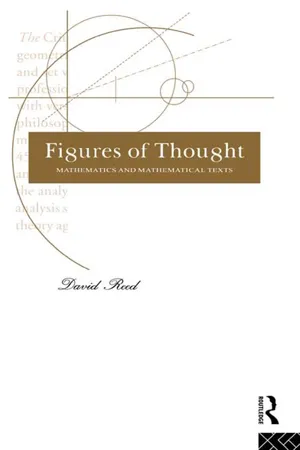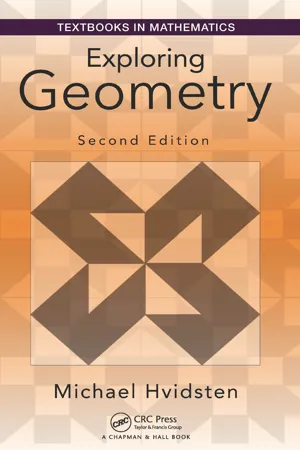Mathematics
Parallel Lines
Parallel lines are two straight lines that never meet, no matter how far they are extended. In geometry, parallel lines have the same slope and will never intersect. They are always equidistant from each other and can be found in various mathematical and real-world applications, such as in architecture and engineering.
Written by Perlego with AI-assistance
Related key terms
3 Key excerpts on "Parallel Lines"
- eBook - ePub
Figures of Thought
Mathematics and Mathematical Texts
- David Reed(Author)
- 2003(Publication Date)
- Routledge(Publisher)
Following the general definitions of boundary and figure Euclid gives a series of definitions (15–22) which proceed in terms of the complexity of the boundary of the figure, i.e. the number of lines which constitute the boundary. All of the definitions operate by defining the boundary of the figure following the equation of boundary with definition in Definition 13.In the case of a circle, the boundary is a single line without other parts and is defined in terms of its relationship to the centre point of the circle. In connection with the equal radii which form the basis for the definition, Euclid follows the procedure previously noted in the discussion of the definition of right angle whereby equality operates as a basic concept of measurement and precedes all specification of the measurement of the thing in question (in this case lines). In other words, circles are contexts in which the equality of lines can be determined.In the case of rectilinear figures, these are defined in terms of the parts of their boundaries and the relationship of these parts to each other. The definitions proceed from the circle which has one line as its boundary, to the semicircle which has two lines, to the triangle which has three and so on. These definitions do not require further elaboration here.1.8 Parallel Lines–the final boundary
The last definition breaks the sequence of ‘figures’ and provides a final ‘limit’ to the definitions in a manner reminiscent of the initial ‘limit’ provided by Definition 1. The two definitions share a negative grammatical construction and both indicate extremes of discourse and intelligibility.Parallel Lines are the final context in which the materials of Definitions 1–7 are set. The context is defined by negation and is in certain respects the ‘contrary’ of angle. As will be seen, the conventional view of the function of Parallel Lines in Euclidean geometry in specifying the curvature of space is not an appropriate reading of the Elements .The rather convoluted wording of Definition 23 is an indication of the intent behind it. By defining Parallel Lines as lines in a plane18 - eBook - ePub
- Donald M. Davis(Author)
- 2013(Publication Date)
- Dover Publications(Publisher)
Let’s make two more comments on these definitions: (i) Definition 3 basically says that lines are composed of points; if “point” and “line” were undefined, this would be a postulate. (ii) Definition 4 may be trying to say that a straight line is the shortest distance between points on it. Euclid never said this explicitly; Archimedes did.There are nineteen more definitions in Book 1 of the Elements . Here are a few of the most important ones. Note that words such as “right angle” and “circle” are defined in terms of earlier words such as “point” and “line” and do not need to be taken as undefined.Definition 10. When a straight line set up on a straight line makes the adjacent angles equal to one another, each of the equal angles is right . Definition 15. A circle is a plane figure contained by one line such that all the straight lines falling upon it from one point among those lying within the figure are equal to one another. Definition 23. Parallel straight lines are straight lines which, being in the same plane and being produced indefinitely in both directions, do not meet another in either direction. These definitions make no claim about the existence of the defined notions. Existence will be asserted in postulates or proved in the propositions. Euclid makes no mention of degrees. One can get by perfectly well with the notion of “right angle” or “straight angle” and fractions thereof. That seems a bit overly formal for a book such as ours, and we will adopt the customary definition of a degree as the size of an angle 1 /90 of a right angle. We will not use the radian measure of angles used in calculus and other forms of higher mathematics.Now for the postulates, which Euclid divided into two groups. There are five postulates, which are assumptions quite specific to geometry, and will be the focus of most of our attention. Then there are five Common Notions, or Axioms, which underlie all of mathematics. - eBook - ePub
- Michael Hvidsten(Author)
- 2016(Publication Date)
- Chapman and Hall/CRC(Publisher)
In the proof of this result found in the on-line chapter on Hilbert’s axioms, we note that the proof uses the idea of extending a segment along a line, which is the focus of Euclid’s second axiom. Geometers have often intuitively understood this axiom to imply that a line has infinite extent, or length. A careful reading of the second Euclidean axiom does not support this understanding.In fact, consider the “spherical” geometry introduced in Exercise 1.6.7 of Chapter 1 . Here we interpreted the term point to mean a point on a sphere and a line to be a part of a great circle on the sphere. In this geometry segments can always be extended (you can always move around the great circle, even though you may re-trace your path), but lines are not infinite in extent.We will return to this question of the boundedness of lines in Chapter 8 , where we develop a non-Euclidean geometry akin to that of the sphere.Theorem 2.7 .(Prop. 27 of Book I) If a line n falling on two lines l and m makes the alternate interior angles congruent to one another, then the two lines l and m must be parallel (Figure 2.5 ).Figure 2.5 Alternate interior anglesTheorem 2.8 .(Prop. 28 of Book I) If a line n falling on two lines l and m makes corresponding angles congruent, or if the sum of the measures of the interior angles on the same side equal two right angles, then l and m are parallel (Figure 2.6 ).Figure 2.6 Angles and parallelsWe note here that all of the preceding theorems are independent of the fifth Euclidean postulate, the parallel postulate. That is, they can be proved from an axiom set that does not include the fifth postulate. Such results form the basis of what is called absolute or neutral geometry. All of the theorems and results found in the on-line chapter on Hilbert’s axioms, except the section on Euclidean Geometry, are independent of the parallel postulate and thus form the basis for neutral geometry.The first time that Euclid actually used the fifth postulate in a proof was for Proposition 29 of Book I. Recall that the fifth postulate states:
Index pages curate the most relevant extracts from our library of academic textbooks. They’ve been created using an in-house natural language model (NLM), each adding context and meaning to key research topics.


